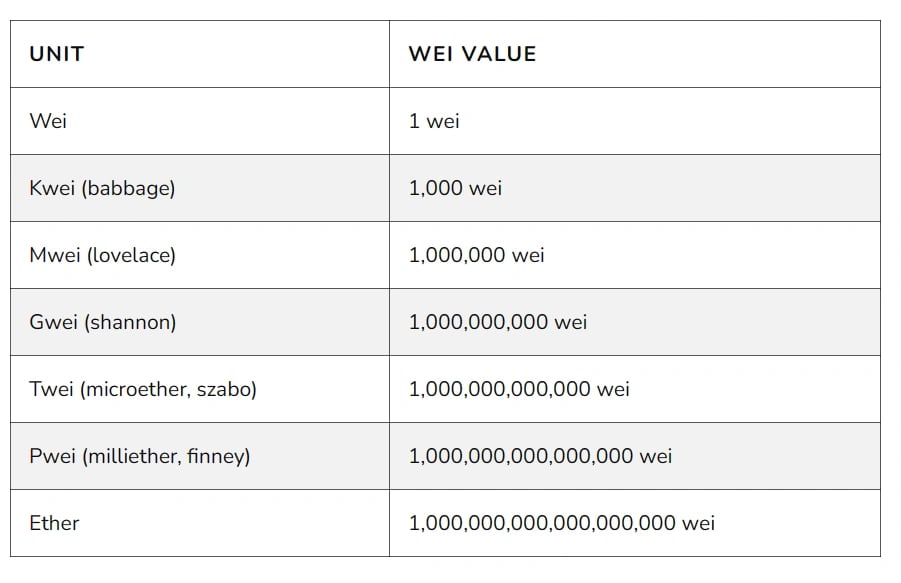订阅 wiki
Share wiki
Bookmark
Gwei
Gwei
Gwei,是以太坊区块链的原生货币以太币(ETH)的一种小面额加密货币。Gwei是gigawei的缩写,也称为nanoether,或简称为nano,表示ETH的九次方分之一。这个术语也被广泛用于谈论gas,以及以太坊网络的交易费用。[1][4] [5]
概述
Gwei是“Giga Wei”的缩写,相当于十亿分之一以太坊,即0.000000001 ETH。一个gwei也被称为nanoether,它是以太币的十亿分之一。Gwei是最常用的以太币单位,因为它被用来表示gas。Gas是在以太坊网络中用于交易能力的术语。Gas费用是用户支付给矿工和验证者的费用,用于补偿在以太坊区块链上处理和验证交易所需的计算能量。[6]
1 Gwei等于10亿(1,000,000,000)Wei,其中Wei是以太币的最小面额。由于以太币的价值可能会发生显著变化,因此使用Gwei作为gas成本的计量单位有助于标准化交易费用和网络使用。如果说一笔交易的gas价格为20 Gwei,这意味着对于该交易中的每个计算步骤或操作,发送者愿意支付200亿Wei(或0.00000002 ETH)作为费用给矿工,以处理该交易。Gas价格是决定交易优先级的一个因素,较高的gas价格通常会导致更快的交易确认时间。在以太坊网络俚语中,Gwei有时也被称为香农(shannon),以纪念美国数学家和计算机科学家克劳德·E·香农。香农被认为是信息论的奠基人。[6][7][8]
以太币的面额
Wei (Wei) - 戴伟提出了所有现代加密货币的概念,并以比特币的前身B-money的创造者而闻名。
Kwei (Babbage) 以查尔斯·巴贝奇(Charles Babbage,1791-1871)的名字命名,他是一位英国数学家和机械工程师,被认为是计算机之父。巴贝奇的分析机(一种机械计算机)的设计将启发现代计算机科学家。现代对他的设计的重现已经成功地证明了他的想法如果可以建造的话是可行的。
Mwei (Lovelace) 以艾达·洛夫莱斯(Ada Lovelace,1815-1852)的名字命名,她是一位才华横溢的数学家,也是诗人拜伦勋爵的女儿,曾与巴贝奇合作。她编写了许多人认为的第一个计算机程序,如果引擎建成,该程序将推导出伯努利数。她还提出了将织布机的穿孔卡片应用于将一系列指令输入巴贝奇的分析引擎的想法。
Gwei (Shannon) 以克劳德·香农(Claude Shannon,1916-2001)的名字命名,他是一位美国数学家和电气工程师,被称为“信息论之父”。香农还设计了可以解决布尔代数的早期数字电路。他的工作为我们今天使用的数字计算机和网络奠定了基础。
Twei (Szabo) 以尼克·萨博(Nick Szabo)的名字命名,他是一位计算机科学家、法学学者和密码学家,以其在数字合约和数字货币方面的开创性研究而闻名。萨博设计了bit gold,一种去中心化的数字货币,据说也影响了中本聪的比特币设计。萨博提出并创造了“智能合约”一词。
Pwei (Finney) 以哈尔·芬尼(Hal Finney,1956-2014)的名字命名,他是一位密码学活动家、PGP公司的开发人员、可重复使用的工作量证明的创建者和比特币的早期贡献者。据称,芬尼是比特币交易的第一个接收者,该交易由中本聪本人发送。
Ether (Buterin) 以Vitalik Buterin的名字命名,他是以太坊的创造者。[2][3]
发现错误了吗?

